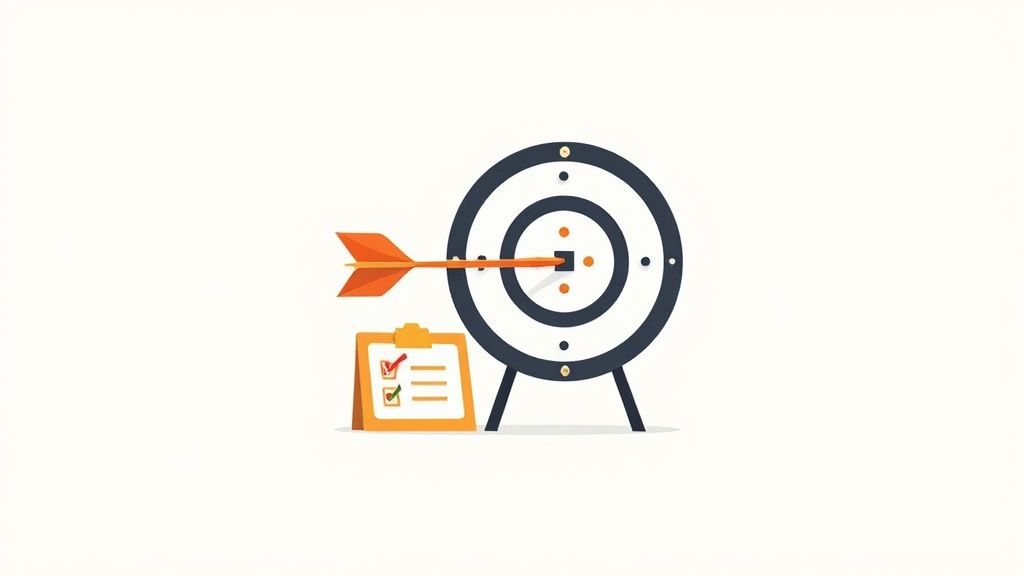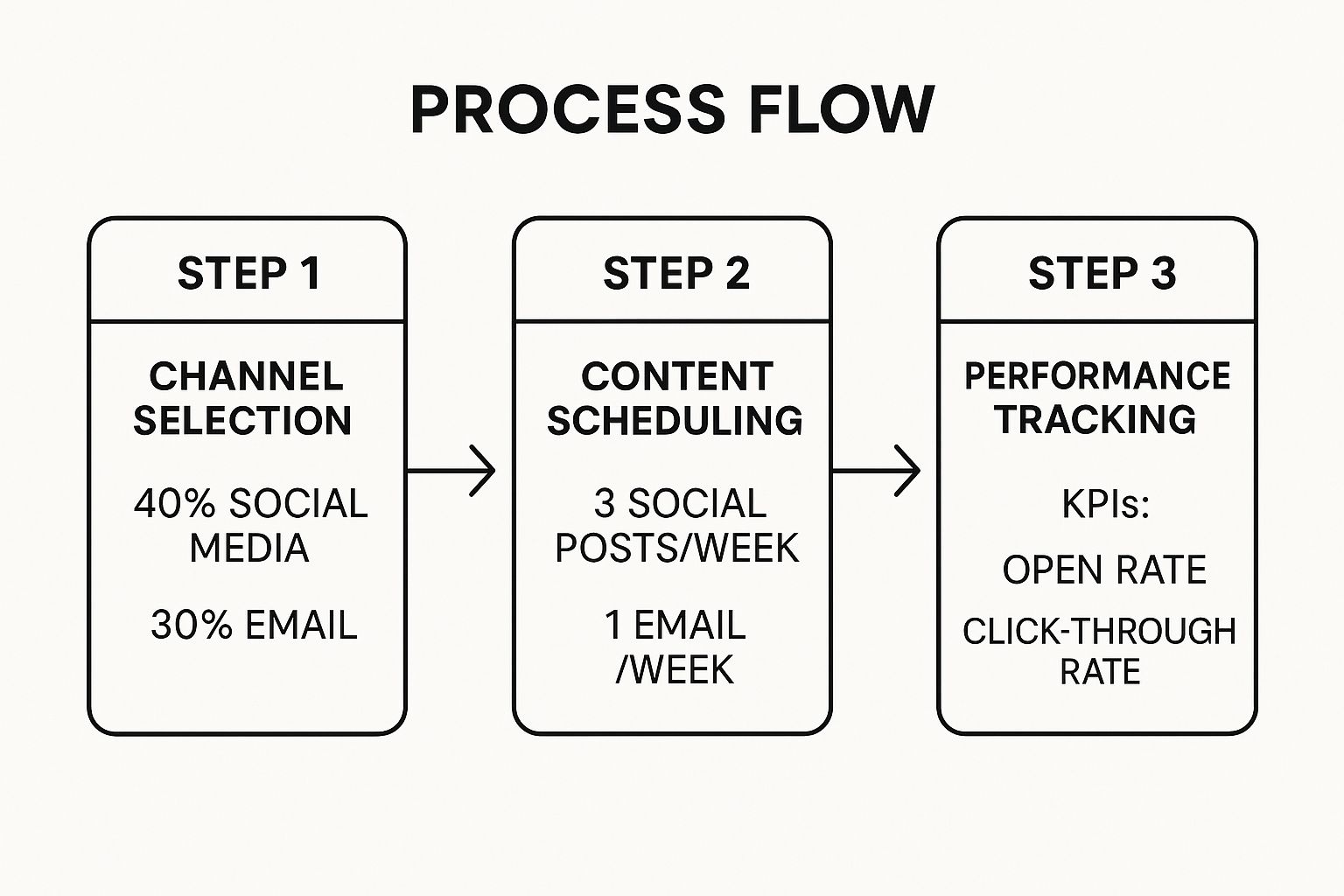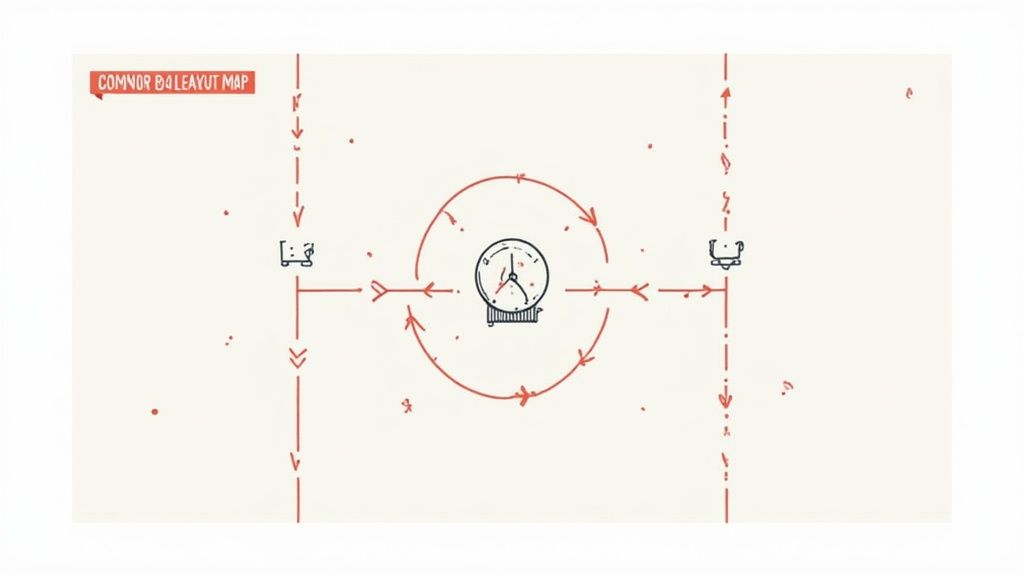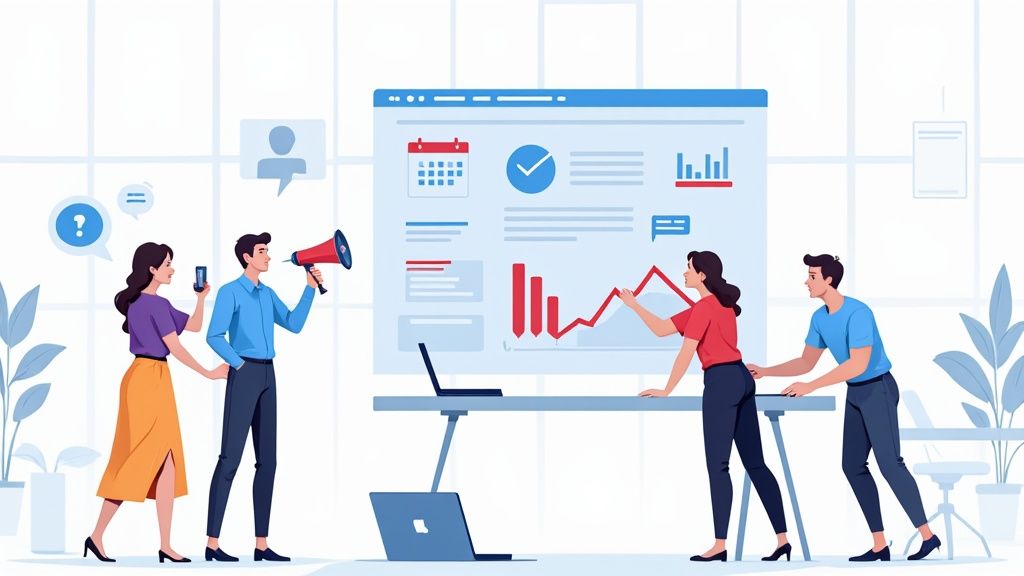Think of your event marketing plan as more than just a document. It’s your strategic roadmap, the detailed guide that lays out your goals, target audience, budget, promotion plan, and how you’ll measure success. This isn't just about throwing a great party; it’s about turning a gathering into a powerful marketing engine that delivers real results.
Why a Marketing Plan is Your Event's Secret Weapon

Let’s be real. An event without a plan is just a get-together with your fingers crossed. A solid event marketing plan isn't some formal, dusty binder that sits on a shelf. It’s the game plan that transforms a potentially expensive outing into a measurable investment. It forces you to move beyond a simple to-do list and get your entire team—from marketing to sales—on the same page, all working toward the same goals.
This kind of alignment is everything. When your teams are working in silos, you lose all your momentum. Marketing might blast out an email, but the sales team has no idea who's actually interested. The events crew books a fantastic venue, but half the company doesn't even know the date. It’s a classic recipe for confusion and wasted opportunities.
✦Getting Your Whole Team on Board
For companies that rely on both Slack and Google Calendar for internal operations, keeping everyone in the loop is a constant struggle. We’ve all seen it: email invites get buried, calendar pop-ups are ignored, and crucial event details just never make it to the right people. This communication gap can seriously undermine your event's success before it even begins.
This is where having the right tools makes all the difference. A platform like Be There is particularly useful because it directly connects your event planning calendar with your team’s daily communication hub. It works by automatically pushing your Google Calendar events into specific Slack channels, guaranteeing everyone sees what’s coming up. Team members can RSVP with a click and get all the updates without ever leaving the app they use for work all day long. It's a simple, handy way to build internal buzz that naturally spills over to your external audience.
A great plan does more than just organize tasks—it builds momentum from the inside out. When your own team is genuinely excited and informed about an event, they become your most passionate advocates. That’s how you generate real, organic interest.
✦Turning Events from a Cost into a Moneymaker
A clear, strategic plan is also your best tool for getting a bigger budget. Instead of just asking for cash, you’re presenting a solid business case with expected returns. The data is on your side here; event marketing is one of the most powerful channels out there.
In fact, a whopping 78% of organizers say in-person events are their most effective marketing tool. This has led to a major comeback for live gatherings, with 60% of events now being held in-person.
Ultimately, a good plan forces you to think ahead. It helps you anticipate and prepare for potential problems, from low registration numbers to last-minute tech failures. To get into the nitty-gritty of planning, you can find more details in our guide on how to plan corporate events. It’s all about shifting your focus from simply "hosting an event" to "running a strategic marketing campaign" that drives tangible business growth.
Defining Clear Goals and Your Ideal Attendee

Before you even think about drafting a single promotional email or scouting a venue, you have to nail down the most critical part of your event marketing plan: what are you trying to achieve, and who are you trying to reach? Let’s be honest, an event without clear goals is just an expensive party. You have to define success before you can actually achieve it.
Are you aiming to generate a specific number of sales-qualified leads for a new product launch? Maybe the goal is to cement your company's reputation as a thought leader in a crowded space. Or perhaps you just want to build a stronger community by celebrating your existing customers.
Whatever the reason, it needs to be concrete. Vague ambitions like "increasing brand awareness" are impossible to measure and even harder to justify. Instead, it’s much smarter to frame your goals using the SMART framework—making sure they are Specific, Measurable, Achievable, Relevant, and Time-bound.
✦Setting SMART Goals for Your Event
Instead of a fuzzy goal like "more awareness," a much better target sounds something like this: "Generate 150 qualified leads from enterprise-level companies in the fintech sector by the end of Q3." Now that gives your team a clear target to aim for and a solid benchmark to measure your efforts against.
Here are a few more examples of strong, measurable event goals I’ve seen work well:
- Customer Retention: Achieve a 90% satisfaction rate among current customers attending, which you can easily measure with post-event surveys.
- Lead Generation: Secure 50 scheduled product demos with new prospects within two weeks after the event wraps up.
- Brand Authority: Attract at least 200 attendees for a specific industry panel and land 10 media mentions in relevant trade publications.
The event marketing industry is absolutely booming, and it’s on track to hit a market size of $722.67 billion by 2028. It’s no surprise that event professionals are laser-focused on balancing customer acquisition with retention. In fact, a recent study showed that 71% use events for both, while 21% focus mainly on retention—a strategy that makes them 13% more likely to see annual growth over 10%.
✦Crafting Your Ideal Attendee Persona
Once your goals are locked in, you have to get crystal clear on who needs to be in the room (or on the webinar) to help you hit those numbers. This goes way beyond basic demographics. You need to build a detailed attendee persona, which is essentially a semi-fictional profile of your perfect guest.
Really dig deep here. What's their job title? What are their biggest professional headaches or pain points? What kind of content would make them stop scrolling and register immediately?
An ideal attendee persona isn’t just about who you want at your event; it’s about understanding who needs to be there. When you know their motivations, you can craft every piece of your event—from the session topics to the networking opportunities—to resonate with them on a personal level.
To truly get inside their heads, I always recommend diving into the process of defining your buyer persona, as it will seriously help you refine your attendee profiles. This level of detail is what makes your marketing messages sharp, relevant, and impossible to ignore.
✦Aligning Event Goals with Business Objectives
Finally, and this is a big one, your event goals have to connect directly to the company's bigger objectives. This is how you prove the value of your event marketing plan to stakeholders and, most importantly, secure your budget for next time. If the company’s Q4 priority is expanding into the European market, then your event should be designed to support exactly that.
For example, you could host a virtual summit targeted specifically at decision-makers in London and Berlin. The event's success would then be measured by how many new European leads it added to the sales pipeline. When you do this, your event stops being just another marketing activity and becomes a crucial part of the company's growth story.
Building Pre-Event Buzz That Drives Registration
Let's be honest, the fate of your event is often sealed long before the doors open. That critical period in the weeks and months leading up to it? That’s where the magic happens. It’s where you build the momentum that separates a sold-out smash hit from a room full of empty chairs. A strong pre-event promotion plan isn’t just a nice-to-have; it’s the engine that generates real excitement, proves your event’s value, and puts butts in seats.
This is about more than just firing off a single email blast and crossing your fingers. It takes a coordinated, multi-channel game plan that meets your ideal attendees right where they are. We're talking about a meticulously planned promotion calendar that weaves together targeted emails, compelling social media, and smart partnerships to create a steady drumbeat of anticipation.
✦The Power of Internal Momentum
So many organizations miss the mark on their most powerful promotional asset: their own people. Your team members can be your most authentic and passionate advocates, but only if they’re actually in the loop and excited about what’s happening. Too often, internal friction kills external buzz before it even gets started.
Think about the standard process. Someone creates an event in a calendar, a bland email goes out to the whole company, and it’s immediately buried under a pile of other messages. The sales team doesn’t know the key talking points, customer support isn't sure about the date, and the marketing team is left shouldering the entire promotional burden alone.
It’s a massive—and completely avoidable—missed opportunity.
✦A Game-Changer for Slack and Google Calendar Teams
For companies running on Slack and Google Calendar, there’s a much smarter way to build this internal energy. A tool like Be There is incredibly handy for this exact problem. It acts as the bridge between your planning tool (Google Calendar) and your communication hub (Slack), completely wiping out the usual friction of internal event promotion.
Picture this: your event manager creates the "Q3 Product Launch Webinar" in Google Calendar. Instantly, a sharp, professional-looking announcement pops up in the #general or #marketing Slack channel. It's not some clunky, robotic notification. It’s a visually appealing card with the event title, date, time, and a branded image.
And here's the best part: it has a clear RSVP button right there in Slack.
This screenshot shows you exactly how Be There transforms a simple calendar entry into an engaging, interactive post inside the one app your team is already using all day long. For any company that uses both Slack and Google Calendar, this tool is very useful because it makes it ridiculously easy for people to see what’s going on and get involved, without ever having to switch apps or hunt through their inbox.
This one small tweak creates a huge ripple effect. When your own team is genuinely buzzing about an event, that enthusiasm is contagious. It leads to more authentic social sharing, better-informed conversations with clients, and a unified front that builds serious external credibility.
✦Crafting Your Multi-Channel Promotion Calendar
Once you’ve got your internal team fired up, you can turn that energy outward. A well-organized promotion calendar is your roadmap for making sure your message is consistent, timely, and hits the mark across every platform.
Think of your calendar in phases:
- 12+ Weeks Out (The Teaser Phase): Time to plant the seed. Announce the date and theme. Start sharing blog posts or articles related to your event's main topics. The goal here isn't to sell tickets yet, but to establish your event as a relevant, must-attend gathering.
- 8-10 Weeks Out (The Early Bird Phase): Registration is officially open! This is when you hit your email list hard and launch targeted paid ads. An early bird discount works wonders here, creating a sense of urgency and rewarding your most loyal fans.
- 4-6 Weeks Out (The Content Deep Dive): Start pulling back the curtain. Announce your keynote speakers, publish the full agenda, and share sneak peeks of key sessions. Use social media to run polls asking what people are most excited about, and post behind-the-scenes photos of your team getting everything ready.
- 1-2 Weeks Out (The Final Push): This is your last shot to fill every spot. Your messaging should be all about scarcity and the fear of missing out (FOMO). Think "last chance to register" emails, countdowns on social media, and getting your speakers and sponsors to share with their networks one final time.
Building buzz is a marathon, not a sprint. A layered promotional strategy that builds over time is far more effective than a single, loud announcement. Each phase should create a new reason for your audience to pay attention and take the next step.
Throughout this whole process, consistency is everything. Your branding, messaging, and tone need to be locked in across your event website, emails, social media, and ads. This projects a professional and trustworthy image, giving potential attendees the confidence they need to invest their time and money in what you're building. When you combine a powerful external push with a frictionless internal strategy, you create an unstoppable force that drives registration and sets the stage for a truly killer event.
Executing a Flawless Event Experience
This is it. The big day. All your planning, goal-setting, and promotion have led to this moment. Whether your attendees are walking through a physical door or clicking a login link, their experience starts now. A seamless, engaging event is what people remember and what they’ll associate with your brand long after the day is done.
Honestly, pulling off a great event isn't about grand, sweeping gestures. It's about getting the thousand little details right. It’s the small things that make the difference between a day that feels clunky and one that feels effortless.
✦Mastering the On-Site and Virtual Flow
For an in-person event, the vibe is set the second someone arrives. A smooth, fast registration process is your first win. Think clear, unmissable signage and friendly staff who actually know where everything is. Your mission is to get rid of any friction and make it easy for people to connect.
With virtual events, your platform is the venue. You don’t have the buzz of a physical crowd, so you have to create that energy yourself. This is where tools like live polls, Q&A sessions, and well-managed breakout rooms are your best friends. They get people to lean in and participate instead of just passively watching a screen.
The promotional rhythm you set leading up to the event plays a huge role in building that initial excitement. It’s all about a balanced mix of channels to get the word out.

Think of it as a steady drumbeat of communication—enough to build anticipation without driving everyone crazy with notifications.
✦The Command Center for Modern Teams
Let's talk about one of the biggest event-day headaches: coordinating your own team. Staff are spread out, volunteers need guidance, and your boss wants updates now. This is where communication falls apart. Email is way too slow, and a storm of text messages is just pure chaos.
If your company already lives in Slack and Google Calendar, there’s a much better way. A tool like Be There is very handy for this, turning those everyday apps into a powerful event-day command center. It syncs what’s supposed to happen (your Google Calendar schedule) with what’s actually happening (the real-time chat in Slack), keeping your entire on-site and virtual staff perfectly aligned.
Picture this: your on-site team is in a private Slack channel. A speaker is running 10 minutes late. Instead of a frantic game of telephone, one person posts the update. Instantly, the stage manager, the A/V crew, and the speaker’s host are all in the loop and can adapt on the fly. No panic, just a quick pivot.
A well-coordinated internal team is invisible to attendees but essential to a smooth experience. When your team communicates seamlessly, problems are solved before they can impact your guests, creating an atmosphere that feels effortless and professional.
This kind of organized, real-time communication is the backbone of great project management for events. It lets you stay ahead of issues instead of constantly reacting to them.
✦Your Event Day Execution Checklist
To make sure nothing slips through the cracks, a solid checklist is non-negotiable. It’s the single source of truth that keeps your entire team aligned when things get hectic. While every event has its own quirks, some fundamentals always apply.
To help you get started, here's a quick-reference checklist covering the essentials for both virtual and in-person events.
✦Essential Event Day Checklist
| Task Area | In-Person Focus | Virtual Focus |
|---|---|---|
| Tech & A/V | Test all mics, projectors, and Wi-Fi at least an hour before doors open. | Run a full tech rehearsal with speakers the day before. Check all links and access. |
| Team Comms | Hold a pre-event huddle to review roles, schedules, and emergency plans. | Have a dedicated "backstage" chat channel for mods, speakers, and tech support. |
| Venue/Platform | Walk the space from an attendee's view. Is signage clear? Restrooms easy to find? | Log in as an attendee to test the user flow. Is it easy to find sessions? Is chat intuitive? |
| Registration | Ensure check-in stations are fully staffed and tested. Have a plan for walk-ins. | Monitor the login process for any attendee issues. Have tech support on standby. |
| Content | Confirm speaker slides are loaded and ready. Check any presentation remotes. | Double-check that all pre-recorded content plays correctly and live stream is stable. |
By really nailing these execution details, you’re not just running an event; you’re creating an atmosphere. This is where your brand comes to life, turning a well-planned day into an experience that people will be talking about for weeks.
Turning Post-Event Follow-Up Into Real ROI

The event isn't over when the lights go down. I’ve seen it time and time again: the real magic happens in the days and weeks that follow. This is where all those great conversations and handshakes transform into tangible business results. A solid follow-up strategy is what separates a forgettable event from one that fuels your pipeline for months.
This is about much more than a generic "thank you" email. It's a deliberate process designed to nurture those new relationships and guide people to the next step, whether that's a demo, a sales call, or simply becoming a fan of your brand. The goal is to keep the momentum going long after the last session ends.
✦Don't Treat Everyone the Same: Segment Your Follow-Up
Your first move should be to slice up your attendee list. A one-size-fits-all approach just doesn't work. By segmenting your audience based on who they are and how they interacted with you, you can send personalized messages that actually land.
Here’s a simple way I like to break it down:
- Hot Leads: These are the people who swung by your booth for a demo or asked pointed questions during a session. They need a personal touch from your sales team, and they need it fast.
- Engaged Prospects: This group downloaded your resources, asked a question in the Q&A, or visited your website. They’re clearly interested, so send them targeted content that speaks directly to what they were curious about.
- Current Customers: Don't forget your loyal customers who showed up. A personal thank you goes a long way. Share some exclusive content or tips to help them get even more value from your service.
- No-Shows: Life happens. Just because they couldn't make it doesn't mean the interest isn't there. A friendly "sorry we missed you" email with a link to session recordings can easily re-engage them.
✦Keeping Your Team in Sync with Slack
For companies that use both Slack and Google Calendar, coordinating follow-up can get messy. Sales needs to know who to call, and marketing needs to track the outreach without drowning in email chains.
This is exactly where a tool like Be There is very useful. It syncs your Google Calendar with Slack, letting you spin up a dedicated, private channel just for post-event coordination. You can drop in segmented lists, assign tasks, and watch the progress unfold in real-time. This is an incredibly handy way to keep everyone on the same page and make sure no lead gets left behind in the crucial days following your event.
The speed of your follow-up is directly tied to your conversion rate. A smooth internal process ensures your hottest leads get the attention they deserve while the event is still fresh in their minds.
✦Proving Your Event Was Worth It
Securing budget for the next event means proving this one paid off. But measuring performance is a classic headache—somewhere between 21–26% of marketers say they struggle with tracking event ROI. Still, the optimism is there, with nearly 20% of event professionals expecting to see higher ROI in 2025. You can get a closer look at these trends with these insightful event marketing statistics.
To cut through the noise, just focus on a few key metrics that tie directly back to your original goals.
- Lead Generation & Conversion: How many new leads did you get? More importantly, how many of them turned into qualified sales opportunities?
- Pipeline Influence: Did the event help move any existing deals forward? Sometimes a face-to-face meeting is all it takes to close a deal that's been lingering.
- Customer Retention: If you were focused on existing customers, check your post-event surveys for satisfaction scores. Keep an eye out for an increase in product usage or upsells in the following quarter.
- Cost Per Lead: This one is simple but powerful. Divide your total event spend by the number of qualified leads. If you need a deeper dive, check out our guide on budgeting for events.
By connecting these dots, you can build a story that shows the true value of your event. If you want to really nail this final stage, this post-event engagement guide is a fantastic resource. It'll help you build a compelling case that not only justifies the investment but gets everyone excited for the next one.
Common Questions About Event Marketing Plans
https://www.youtube.com/embed/O-wq-C-52NY
Even with the best strategy, event marketing can feel like you're juggling a dozen things at once. It's totally normal to have questions pop up along the way, whether you're a seasoned pro or planning your very first event.
Let's walk through some of the most common questions I hear from teams trying to get their event marketing off the ground.
✦How Far in Advance Should I Start Planning My Event?
Honestly, there’s no magic number here. The right timeline really boils down to the size and scope of your event. The best approach is always to start with your event date and work your way backward.
A massive conference or a multi-day summit? You’ll want to give yourself 9-12 months, minimum. This isn't just about booking a venue; it's about giving yourself enough runway to land incredible speakers and build real marketing momentum.
If you're planning something like a medium-sized workshop or a key product launch, 4-6 months is a solid window. It gives you plenty of time to nail down logistics and promote it properly without that last-minute scramble. For smaller, more agile events like a webinar or an in-person meetup, you can usually get everything done in just 1-2 months.
✦What Are the Biggest Mistakes to Avoid?
I’ve seen a lot of events succeed and a few fall flat, and the difference often comes down to a few key things. The biggest mistake, hands down, is not setting clear, measurable goals from the very beginning. If you can't define what a "win" looks like in concrete terms, how will you know if you got there?
Another classic pitfall is failing to truly get inside the head of your target audience. You have to go deeper than basic demographics. If your messaging and content don't speak directly to their problems and aspirations, your event will feel generic and forgettable.
Finally, internal chaos is a momentum killer. When your marketing team isn't talking to sales, and sales isn't synced with the product team, things fall through the cracks. For companies using both Slack and Google Calendar, this communication disconnect is a common pain point. That's why having a tool that automatically bridges that gap is so critical—it keeps everyone on the same page without adding more work.
✦How Can I Get My Whole Company Excited About an Event?
Getting your internal team fired up is your most powerful marketing tool. Your employees are your best advocates, but they can't cheer for something they don't know about or understand.
For companies that already work in Slack and Google Calendar, the easiest way to generate that internal buzz is with a tool like Be There. It's very handy because it automatically sends your Google Calendar events into specific Slack channels as clean, eye-catching announcements.
When an event just shows up where your team is already talking, it feels effortless. A boring calendar entry becomes an active conversation. It’s a simple shift, but it makes it so much easier for everyone to get excited and start spreading the word.
You should also celebrate milestones in all-hands meetings, give employees pre-made social media snippets to share, and maybe even run a friendly competition to see who can drive the most sign-ups.
✦What Is the Best Way to Keep Virtual Attendees Engaged?
Keeping a virtual audience hooked requires a completely different mindset. You can't just hit "record" on a presentation and hope for the best. Engagement has to be built in from the start.
Make good use of interactive features. Live polls, Q&A sessions, and an active chat box are your best friends. Keep sessions shorter and more dynamic—think punchy talks over long, winding lectures. Breakout rooms are also brilliant for creating those smaller, more intimate conversations that people miss from in-person events.
But none of that matters if your tech fails you. Crisp audio and a stable video stream are absolutely non-negotiable. Technical glitches are the quickest way to lose an audience and look unprofessional. A smooth broadcast is the bedrock of any great virtual event.
Ready to get your whole team on the same page for your next event? Be There connects your Google Calendar to Slack, making internal event promotion effortless. Start your free trial today and see the difference.

Planning your internal events has never been easier!
No more scheduling headaches—our Slack-connected web app keeps things simple. Less email, more fun! 🚀
